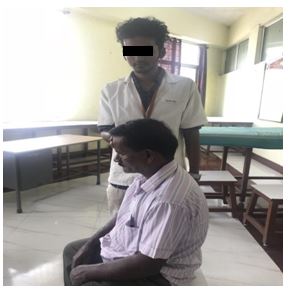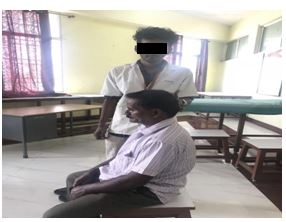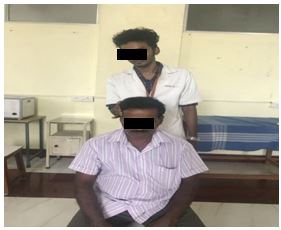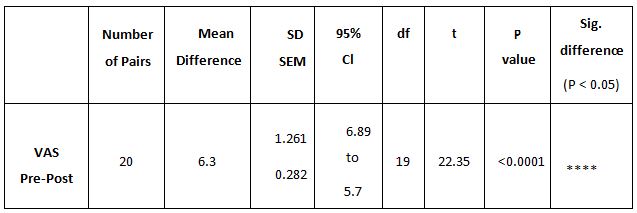Jibi Paul1, Ramamurthy2, Syeda Khanam P3, S. Isaac Bala Singh4
Corresponding Author:
1Professor, Faculty of Physiotherapy, A.C.S. Medical College and Hospital Campus, DR. MGR. Educational and Research Institute, Deemed to be University, Chennai, India
Mail id: physiojibi@gmail.com
Co-Authors:
2Associate Professor, Department of Anatomy, A.C.S. Medical College and Hospital Campus, DR. MGR. Educational and Research Institute, Deemed to be University, Chennai, India
3Professor, East Point College of Physiotherapy, Bangalore, Karnataka, India
4BPT Graduate, Faculty of Physiotherapy, A.C.S. Medical College and Hospital Campus, DR. MGR. Educational and Research Institute, Deemed to be University, Chennai, India
Abstract
| Background of the study: Muscle endurance is the capacity of a gathering of muscle or muscle to support rehashed compressions against an obstruction for a lengthy timeframe. Due to neck pain the endurance of the cervical muscles is been reduced. Aim and Objective of the study is effectiveness of cervical muscle endurance in patients with mechanical neck pain. Methodology: Patients in the age group of (35-50 years) with mechanical neck pain were included in study. 20 patients were selected with mechanical neck pain in A.C.S. Medical College and Hospital, Chennai. Cervical muscle endurance exercises of isometrics were given to the subjects to improve cervical muscle endurance. After 4 weeks the cervical endurance was measured by dial mode sphygmomanometer and analysis of the study was done. Outcome measures of the study were deep cervical flexors and cervical extensors muscle endurance has taken at pre-test and post-test at end of study. Result: Paired t’ test t’ test was done to think about the post treatment scores of both the gatherings. The aggravation power is viewed as essentially diminished in Post-test than the Pre-test with p<0.001. Conclusion: This review shows that the dynamic perseverance practice is advantageous in easing mechanical neck pain and ought to be consolidated alongside the customary physiotherapy treatment for mechanical neck pain. |
Keywords: Cervical muscle; Mechanical Neck Pain; Muscle Endurance; Dial mode Sphygmomanometer.
Received on 08th October 2021, Revised on 24th November 2021, Accepted on 26th November 2021 DOI:10.36678/IJMAES.2021.V07I04.004
INTRODUCTION
Neck is comprised of vertebrae that reach out from the skull to the upper middle. Cervical circles retain shock between the bones. The bones, tendons, and muscles of our neck support our head and take into account movement. Any anomalies, aggravation, or injury can cause neck agony or firmness 1, 2.Neck torment might emerge because of strong snugness in either the neck and upper back, or squeezing of the nerves exuding from the cervical vertebrae3.
The neck is the piece of the human body that appends the head to the remainder of the body. It is comprised of many muscles that are associated from the head to the middle of the body. The motivation behind the neck muscles is either to take into consideration neck development or to offer primary help for the head 4. The movement is either pivot, which means side-to-side; parallel flexion, which means ear to bear; flexion, which means jaw line to sternum; and hypertension, which means looking up5.
Longus colli and capitis, Infrahyoid, suprahyoid, Splenius capitis, splenius cervis, semispinalis capitis muscles, suboccipitals trapezius muscles, and sternocleido-mastoid muscles, are some of the neck muscles associated with neck 6, 7.
Endurance is is simply the capacity of a living being to endeavor and stay dynamic for a significant stretch of time, just as its capacity to oppose, withstand, recuperate from, and have resistance to injury, wounds, or weakness. It is typically utilized in vigorous or anaerobic exercise8,9,10. The meaning of ‘long’ fluctuates as per the sort of effort – minutes for focused energy anaerobic exercise, hours or days for low power vigorous exercise. Preparing for perseverance can contrarily affect the capacity to apply perseverance strength except if an individual likewise embraces opposition preparing to neutralize this impact11.
Isometric exercise is a sort of solidarity preparing in which the joint point and muscle length don’t change during constriction (contrasted with concentric or capricious withdrawals, called dynamic/isotonic developments)12, 13. Isometrics are done in static positions, rather than being dynamic through a scope of motion14.
Objective of the study: The objective of the study is to find the effectiveness of cervical muscle endurance training in patients with mechanical neck pain.
This was a quasi experimental study with cross-sectional Pre and Post-test type. Study was conducted on department of physiotherapy A.C.S. Medical College and Hospital. Total 20 Subjects used to conduct this study. Convenient sampling method used to select the samples from the population. The study was conducted for duration 3 months with an intervention duration of 4 weeks
Selection Criteria: Inclusion criteria were patients with mechanical neckpain and subjects with age group 35-50 years old. Exclusion criteria were the subjects with musculo-skeletal complications, subjects with cardiovascular complications and subjects with age group beyond 50 years old were excluded from the study.
Measuring tools were Jull’ stechnique, Visual Analog Scale and material used were Dial mode sphygmomanometer, Couch, Stopwatch. Outcome measures for the study were VAS scale for pain, Jull’s measurement for endurance.
Procedure: 20 patients were taken from the A.C.S. Hospital and divided into two groups, each group contains 10 individuals. Group A-Treatment group, Group B- Control group Patients in the age group of (35-50 years) with mechanical neck pain included in study .cervical muscle endurance will be measured by using Dial mode sphygmomanometer (at pre and posttest) deep cervical flexors and cervical extensors endurance training will be given to all the patients for 4 days in a week for 4 weeks. Cervical muscle endurance exercises like isometrics will be given to them to improve cervical muscle endurance. After 4 weeks the cervical endurance can be measured by dial mode sphygmomanometer and an observ-ational study is done.
Exercise Protocol
Isometric Neck Flexion:

Patient in a sitting position and therapist hand placed in forehead, ask the patient to do neck flexion while therapist giving the resistance and hold the position for 15-20 seconds and 3repetition.
Isometric Neck Extension

Patient in a sitting position and therapist hand placed in occipital region, ask the patient to do neck extension while therapist giving the resistance and hold the position for 15-20 seconds and 3repetition.
Isometric lateral flexion:

Patient in a sitting position and therapist hand placed in temporal region, asks the patient to do lateral flexion while therapist giving the resistance and hold the position for 15-20 seconds and 3repetition
Isometric neck rotation:
Patient in a sitting position and therapist hand placed in mandible, ask the patient to do neck rotation while therapist giving the resistance and holdthe position for 15-20 seconds and 3 repetition.

Data Analysis:

The above table reveals the Mean, standard deviation (S.D), t-test, degree of freedom (df) and p value of the VAS within pre-test and post-test weeks.
The above table 1 shows significant difference in VAS after neck endurance training program with mean difference of 6.3 and P<0.0001.

The above table reveals the Mean, standard deviation (S.D), t-test, degree of freedom (df) and p value of the JULL’S score between pre-test and post-test weeks.
The above table 2 shows significant difference in Jull’s score after neck endurance training program with mean difference of 13 and P<0.0001
RESULT
Paired’t’ test was done to contrast the pretreatment scores and the post treatment scores .Unpaired ‘t’ test was done to think about the post treatment scores of both the gatherings. The aggravation force is viewed as fundamentally diminished in Post-test than the Pre-test with p<0.001.
DISCUSSION
There is a significant difference in the post test esteems in VAS and Jull’s scores at p≤0.001 where the determined worth is more noteworthy than the table worth. On looking at post-test mean qualities on VAS and Jull’s shows more powerful at P≤0.001.
Neck torment has been the most widely recognized boss protest among working matured men and lady. Mechanical neck torment regularly emerges treacherously and is by and large multifactorial in beginning, including at least one of the accompanying: helpless stance, uneasiness, discouragement, neck strain and wearing or word related exercises.
Panjabi et al assessed that the neck muscular build contributes 80% to the mechanical soundness of cervical spine while the Osseo ligamentous framework contributes the leftover 20%.Neck aggravation predominance has been accounted for as going from 22% to 30%.In correlation, the year pervasiveness of neck torment in overall public reaches 30 to 50%.Davies et al says that isometric exercise is a static type of activity that happens when a muscle contract without a calculable change in the length of the muscle or without noticeable jointmotion 13,14.
Isometric exercise is normally used to build muscle execution. Mechanical neck pain restricts the cervical development, muscle control and coordination which prompts inability and low quality of life 15, 16 .
Consequences of one randomized controlled preliminary of patients with neck and migraine grievances showed that a gathering of patients who get perseverance works out, endeavoring to focus on the profound neck flexor muscular structure as a component of a multimodal intercession, experienced critical decrease in neck agony and cerebral pain regularly17.
The discoveries of the review pranjal gogoi infer that the mechanical neck pain is multifactorial in beginning however the underlying driver of abrupt agony is because of absence of perseverance in cervical profound muscles 18.
Thisreview centers around the perseverance of cervical muscles which help to battle the repeat of torment because of shortcoming of muscles. The ever-evolving aerobic exercise program builds the perseverance of profound cervical muscles there by decreases the aggravation and handicap. Every one of these can work on the personal satisfaction of the patients and works on the result 19.
A study demonstrates that the helpful impact of solidarity preparing program (isometric obstruction preparing) Increases neck muscle size and strength during sidelong flexion and diminishes the fatigability of shallow muscles of the neck.Isometric strength estimation is a valuable and pragmatic 20 .
Ethical clearance: There was no risk of conducting this study. Ethical clearance was obtained from the ethical Institutional Review Board of Faculty of Physiotherapy, Dr. MGR. Educational and Research Institute, Chennai with reference No. IVB-015/PHYSIO/IRB/2017-2018 approval letter dated 08/01/2018.
Conflicts of Interest: There is no conflict of interest to conduct this study.
Fund for the study: This is self-funded study.
CONCLUSION
The intense exercise program for cervical muscle had altogether builds the perseverance of the cervical muscle separated from pain and incapacity likewise diminishes in the subjects. The subjects getting cervical isometric exercise have critical distinction in perseverance, pain and incapacity. So this study concluded that aerobic exercise program has better result on patients with Mechanical neck pain.
REFERENCES
- Clair DA, Edmondston SJ, Allison GT. Physical therapy treatment dose for nontraumatic neck pain: A comparison between 2 patient groups. J Orthop Sports Phys Ther. 2006;36(11):867-75.
- Binder AI. Cervical spondylosis and neck pain. BMJ. 2007;334: 527-531
- Sarig-Bahat H. Evidence for exercise therapy in mechanical neck disorders. Man Ther. 2003; 8(1): 10-20.
- Hallgren RC, Greenman PE, Rechtien JJ. Atrophy of suboccipital muscles in patients with chronic pain: a pilot study. J Am Osteopath Assoc. 1994; 94(12):1032-1038.
- McPartland JM, Brodeur RR. Rectus capitis posterior minor: a small but important suboccipital muscle. J Bodywork Mov Ther. 1999;3(1):30-35.
- Placzek JD, Pagett BT, Roubal PJ, et al. The influence of the cervical spine on chronic headache in women: a pilot study. Journal of Manual and Manipulative Therapy. 1999;7(1):33–39.
- Beeton K, Jull G. Effectiveness of manipulative physiotherapy in the management of cervicogenic headache: a single case study. Physiotherapy. 1994; 80(7):417-423.
- Vernon H, Mior S: The Neck Disability Index: A study of reliability and validity. J Manipulative Physiol Ther. 1991,14(7):409-415.
- Shaun O Leary Deborah Falla et al. Muscle dysfunction in cervical spine pain: Implications for assessment and management. Journal of orthopedic & sports.2009; 39(5):324-333.
- Aker PD, Gross AR, Goldsmith CH, Peloso P. Conservative management of mechanical neck pain: systematic overview and meta-analysis. BMJ. 1996; 313(7063):1291-1296.
- Ackelman BH, Lindgren U. Validity and reliability of a modified version of the neck disability index. J Rehabil Med. 2002;34(6):284287.
- Borghouts J. A. J., Koes B. W., Vondeling H., Bouter L. M. Cost-of-illness of neck pain in The Netherlands in 1996. Pain. 1999; 80(3):629–636.
- Panjabi MM, Cholewicki J, Nibu K, Grauer J, Babat LB, Dvorak J. Critical load of the human cervical spine: an in vitro experimental study. Clin Biomech (Bristol,Avon). 1998; 13(1):11-17.
- Falla D, Jull G, Hodges PW. Feed forward activity of the cervical flexor muscles during voluntary arm movements is delayed in chronic neck pain. Exp Brain Res. 2004;157:4348.
- Berg HE, Berggren G, Tesch PA, Dynamic neck strength training effect on pain and function, Arch phys Med Rehab 1994; june 75(6);661-5.
- Aker PD, Gross AR Goldsmith CH, peloso P, conservation management of mechanical neck pain; Systematic overview and meta-analysis, BMJ 1996 ;313:1291- 1296.
- Sarig-Bahat H. Evidence for exercise therapy in mechanical neck disorders. Man Ther. 2003;8(1):10-20.
- O’ Leary S, Falla D,Jull G. Recent advances in therapeutic exercise for the neck: implications for patients with head and neck pain. Endod J. 2003;29(3):138-142.
- Jull G,Russel T, Vicenzio B. Effect of neck exercises on sitting posture in patients with mechanical neck pain, phys ther.2007apr;87(4):408-17.
- Placzek JD, Pagett BT, Roubal PJ, et al. The influence of the cervical spine on chronic headache in Women: a pilot study. Journal of manual and manipulative therapy. 1999; 7(1):33-39.
Citation: Jibi Paul, Ramamurthy, Syeda Khanam P,S. Isaac Bala Singh (2021). Effectiveness of cervical muscle endurance training in patients with mechanical neck pain, ijmaes; 7(4); 1148-1154.


Leave a Reply